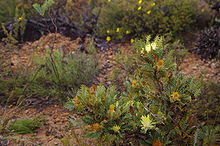- Banksia armata
-
Prickly Dryandra Scientific classification Kingdom: Plantae (unranked): Angiosperms (unranked): Eudicots Order: Proteales Family: Proteaceae Genus: Banksia Subgenus: Banksia subg. Banksia Series: Banksia ser. Dryandra Species: B. armata Binomial name Banksia armata
(R.Br.) A.R.Mast & K.R.ThieleVarieties Banksia armata, commonly known as Prickly Dryandra, is a shrub endemic to Western Australia.
Contents
Description
B. armata grows as a spreading or upright shrub, up to three metres in height. It has deeply serrated leaves. Its inflorescences are usually bright yellow, but may be pink.[1]
Distribution and habitat
The species is widespread throughout most of the south-west. The main distribution is between Perth and Albany, but it also occurs near Mount Lesueur in the north, and between Esperance and Israelite Bay on the south coast. It grows on sandy loam or in rocky soils in tall shrubland or low woodland.[1][2]
Taxonomy
Specimens of B. armata were first collected at King George Sound in December 1801 by Robert Brown. Brown published a description of the species in 1810, naming it Dryandra armata; the specific epithet is from the Latin armatus ("armed") in reference to the sharply serrated leaves. Thirty years later, John Lindley published a purported new species, which he named Dryandra favosa.[3] This was accepted as a species by Carl Meissner in 1845,[4] but declared a taxonomic synonym of D. armata by him in 1856,[5] and the latter view was taken by George Bentham his 1870 Flora Australiensis.[6] In 1996, Alex George published D. a. var. ignicida, resulting in the automatic creation of the autonym D. a. var.armata. George also refined the synonymy of D. favosa to D. armata var. armata.[7] In 2007, all Dryandra species were transferred to Banksia by Austin Mast and Kevin Thiele;[8] hence the current name of this variety is Banksia armata (R.Br.) A.R.Mast & K.R.Thiele.[9]
References
- ^ a b Cavanagh, Tony and Margaret Pieroni (2006). The Dryandras. Melbourne: Australian Plants Society (SGAP Victoria); Perth: Wildflower Society of Western Australia. ISBN 1-876473-54-1.
- ^ "Dryandra armata R.Br.". FloraBase. Department of Environment and Conservation, Government of Western Australia. http://florabase.dec.wa.gov.au/browse/profile/1888.
- ^ Lindley, John (1839). "A Sketch of the Vegetation of the Swan River Colony". Appendix to the first twenty-three volumes of Edwards's Botanical Register. London: James Ridgeway.
- ^ Meissner, Carl (1845). "Dryandra". In Lehmann, Johann. Plantae Preissianae. Hamburg: Meissner. http://gallica.bnf.fr/notice?N=FRBNF37257090&UC=o. Retrieved 2007-09-27.
- ^ Meissner, Carl (1856). "Dryandra". In de Candolle, A. P.. Prodromus systematis naturalis regni vegetabilis. http://gallica.bnf.fr/notice?N=FRBNF37257110&UC=o. Retrieved 2007-09-14.
- ^ Bentham, George (1870). "Banksia". Flora Australiensis. Volume 5: Myoporineae to Proteaceae. London: L. Reeve & Co.. pp. 541–562.
- ^ George, Alex S. (1996). "New taxa and a new infragenetic classification in Dryandra R.Br. (Proteaceae: Grevilleoideae)". Nuytsia 10 (3): 313–408.
- ^ Mast, Austin R. and Kevin Thiele (2007). "The transfer of Dryandra R.Br. to Banksia L.f. (Proteaceae)". Australian Systematic Botany 20: 63–71. doi:10.1071/SB06016.
- ^ "Banksia armata (R.Br.) A.R.Mast & K.R.Thiele". Australian Plant Name Index (APNI), IBIS database. Centre for Plant Biodiversity Research, Australian Government. http://www.anbg.gov.au/cgi-bin/apni?taxon_id=269880.
External links
- "Dryandra armata R.Br.". Flora of Australia Online. Department of the Environment and Heritage, Australian Government. http://www.anbg.gov.au/abrs/online-resources/flora/stddisplay.xsql?pnid=46410.
- "Dryandra armata R.Br.". FloraBase. Department of Environment and Conservation, Government of Western Australia. http://florabase.dec.wa.gov.au/browse/profile/1888.
- "Banksia armata (R.Br.) A.R.Mast & K.R.Thiele". Australian Plant Name Index (APNI), IBIS database. Centre for Plant Biodiversity Research, Australian Government. http://www.anbg.gov.au/cgi-bin/apni?taxon_id=269880.
Categories:- Banksia ser. Dryandra
- Banksia taxa by scientific name
- Plants described in 1810
Wikimedia Foundation. 2010.

